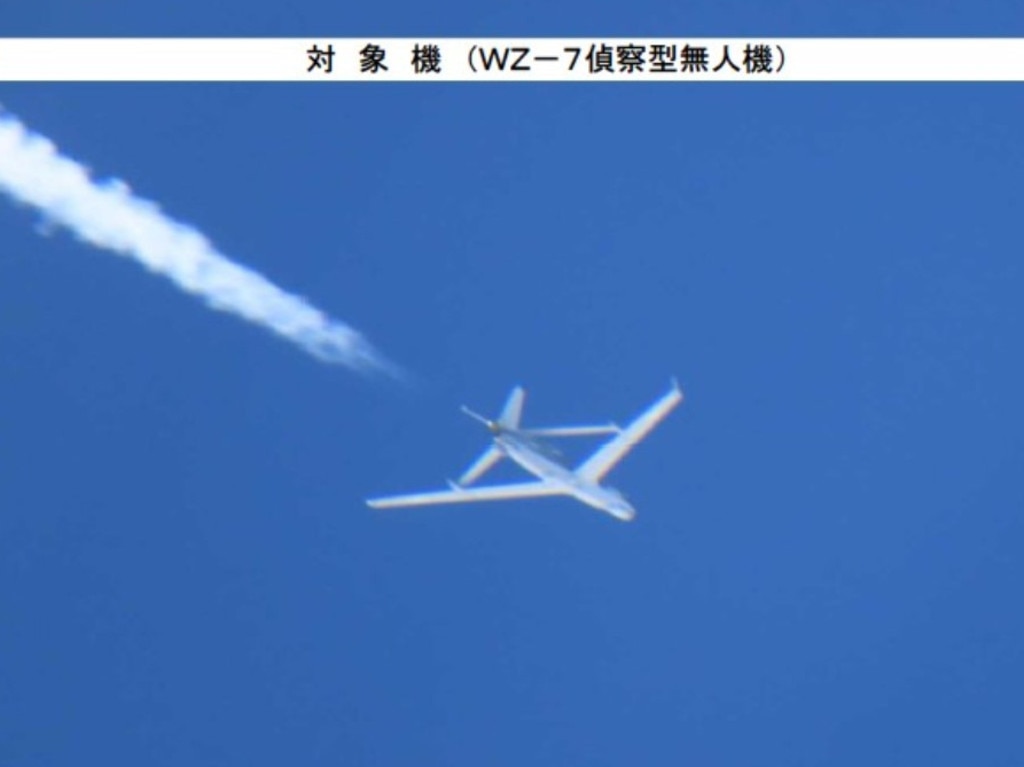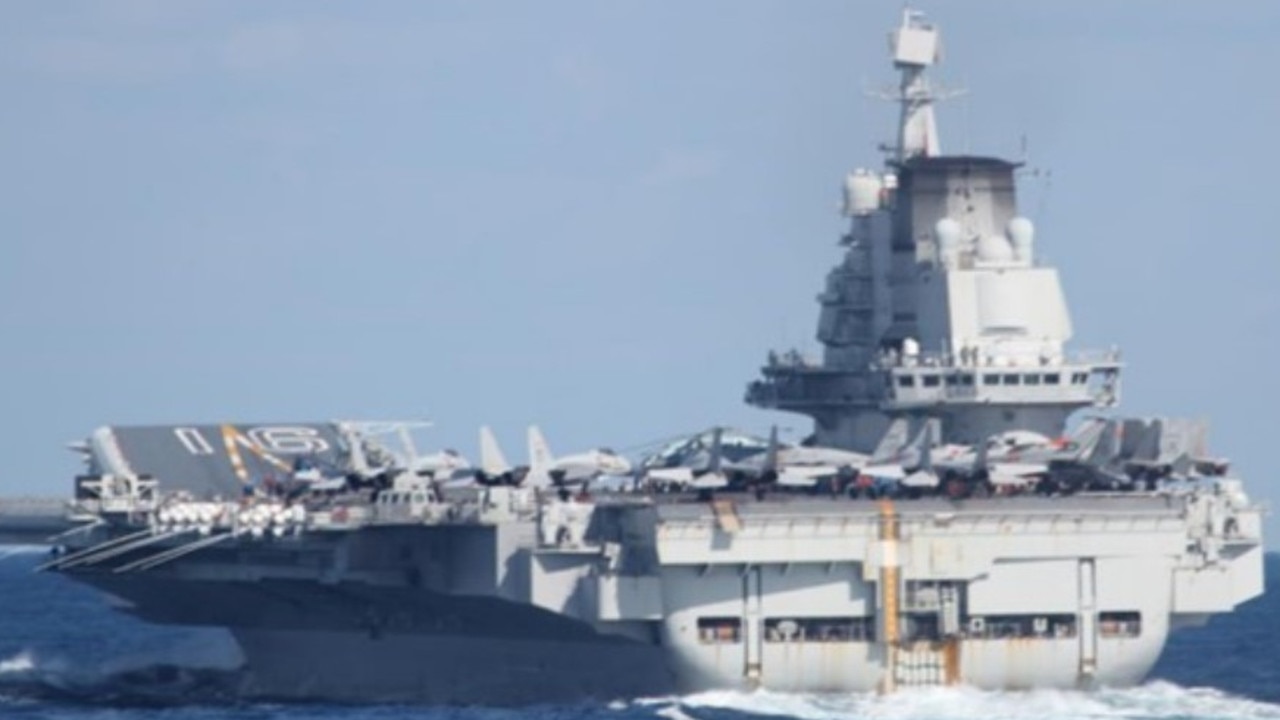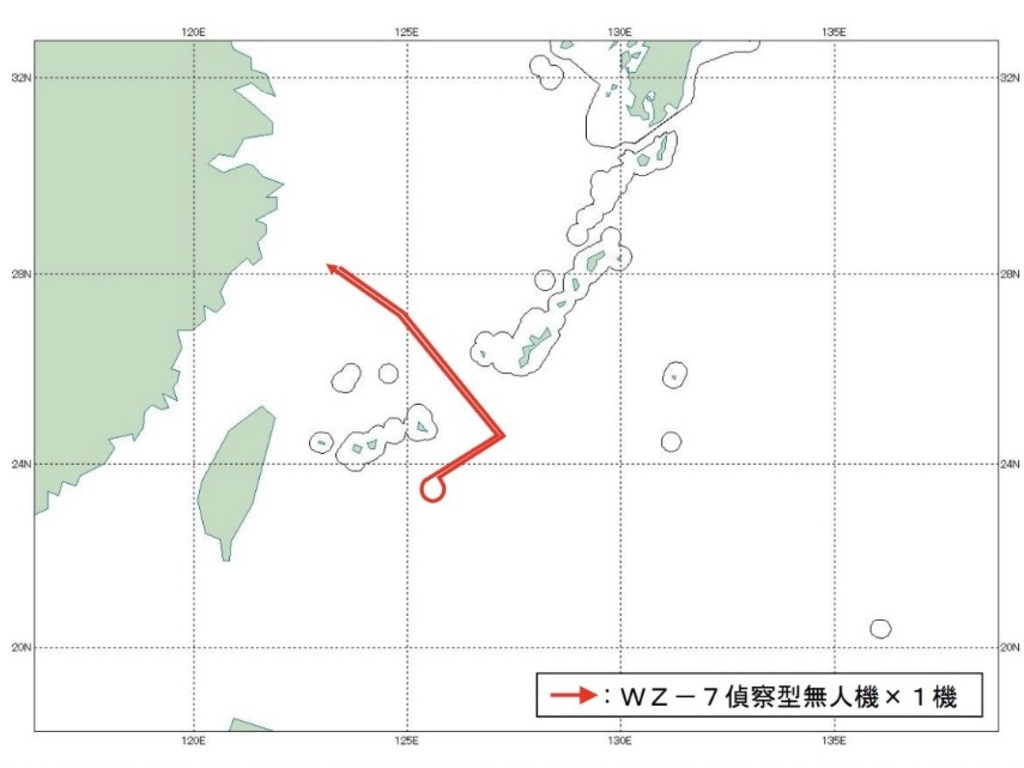China’s wild move in East China Sea signals tense start to 2023
In a tense start to the year, China has aggressively displayed its strength as it ranks one country high on its angst list.

An aircraft carrier battle group. Advanced high-altitude drones. Fighters. Bombers. Wolf Warriors. 2023 is off to a tense start, with China keen to show the world it has a powerful new military – and isn’t afraid to use it.
On January 1, a Chinese naval battle group passed under the nose of US military forces on the Japanese island of Okinawa. It’s now stamping Beijing’s claim to the East China Sea with a series of combat simulations before returning home.
At the same time, new high-altitude uncrewed aerial vehicles (UAVs) flew to and from the Pacific where they have been monitoring US and Japanese activity.

Tokyo scrambled interceptors as the Chinese forces passed through the chain of islands between the Japanese home islands and Taiwan. China – and Taiwan – lay claim to many of these Japanese-occupied territories. And that includes Okinawa.
Japan is now ranked high on China’s angst list.
Last year, Tokyo dramatically increased its defence spending and declared China an “unprecedented strategic challenge”. It has also announced its intention to position missiles on its most exposed islands in the face of increasingly bold Chinese incursions.
“In the past year, China-US relations reached the brink of danger,” a Chinese Communist Party (CCP) approved editorial warns.
“On the Taiwan question, Washington’s insane “extreme testing” of China’s bottom line … has severely hit the political foundation of China-US relations and worsened the already fragile mutual trust between the two countries.”
Power projection
The People’s Liberation Army Navy (PLAN) aircraft carrier Liaoning and its battle group of guided missile cruisers, destroyers and frigates are operating in the East China Sea as its deployment winds to a close.
Japan’s Ministry of Defence said the group passed northwards through the Miyako Strait and into the East China Sea on Sunday. It’s just spent two weeks in the western Pacific, exercising between the First Island Chain (Okinawa, Taiwan, the Philippines and Malaysia) and the Second Island Chain (Japan, Guam, Palau and Papua New Guinea).

Japan scrambled its own fighter aircraft several times during the past few weeks as the aircraft carrier Liaoning launched what some analysts say were simulated attacks on the Ryukyu Island chain. A Japanese destroyer, the JS Ariake, also watched on.
Japanese and US forces also paid close attention to the battle group’s actions as it returned to the East China Sea via Okinawa at the weekend. The Miyako Strait is a strategically significant spot. It’s one of the few channels linking the open Pacific with the confined East China Sea. Whoever controls the air and waterway controls access to a significant portion of China’s major ports.
But most public attention was focused on how close the Chinese aircraft carrier came to a key US strategic outpost.
Yesterday, the JASDF Southwestern Air Defense Force’s fighters scrambled to cope with a suspected intrusion into Japan’s airspace over the East China Sea and the Pacific Ocean.
— Japan Joint Staff (@JapanJointStaff) December 28, 2022
JSDF continues to responding to protect our territory and peace for the people of Japan 24/7. pic.twitter.com/zhJ28n7p7Z
It’s not the first time a Chinese aircraft carrier has ventured into the Pacific. But it is the closest one has passed to the US naval and air force facilities on the remote island of Guam.
Chinese state-controlled media was quick to seize on the move’s significance.
“The Liaoning’s drills in the West Pacific clearly have a tactical background, as it displayed its enhanced capabilities in seizing air superiority and control of sea far away from the homeland,” the Chinese Communist Party’s (CCP’s) Global Times quotes military analyst Song Zhonping as saying.
“The waters south of Japan and west of Guam, both areas in which the Liaoning has held exercises, are important in cutting off military interference forces from the US and Japan”.
Droning on
A sizeable Chinese WZ-7 “Soaring Dragon” drone flew high over the Miyako Strait on Sunday before loitering near the Sakishima Islands, Japan’s Ministry of Defence reported yesterday. This inhabited island group, the scene of fighting between the British and Japanese near the end of the World War, is claimed by China. But most military posturing has previously been focused on the uninhabited Senkaku Islands further west.

A second “Soaring Dragon” followed the same route on New Year’s Day. It also was escorted by Japanese F-15 Eagle fighters.
The distinctive diamond-winged drone was first unveiled in 2021. The jet-powered vehicle is believed to be able to fly at heights of about 60,000ft (18km) for about 24 hours.

It’s now actively engaging in its role of long-range surveillance platform, similar to the US Global Hawk, and Australia’s soon-to-be-delivered, US-built Triton drones.
It was the first time it had been seen operating around Japanese territory. It debuted over the disputed Himalayan border with India earlier in December.
The Hong Kong-based South China Morning Post, now subject to the Chinese Communist Party’s strict national security laws, quotes Beijing-based international relations professor Shi Yinhong as saying the drone operations were a defensive move.
“The drone operations were a continuation of China’s years-long deterrence and combat preparations in response to US-Japan military actions targeting Beijing,” he said, highlighting Tokyo’s moves to strengthen ties with the United States, India, Australia and Taiwan.
He labelled recent moves to double military spending over the next five years as a “radical change” to Japan’s national defence strategy.
The baying of wolves
“The Chinese carrier is ready to defend the country against potential US attacks launched from there (Guam), including military interference attempts over the Taiwan question,” the Global Times quotes unnamed CCP analysts as saying.
“China will never attack US military bases in Guam as long as the US military does not attack China or interfere in the Taiwan question, but having such capabilities is a deterrent against potential US provocations.”
In Beijing, Guam is “considered an important node in the second island chain that is designed to contain China”.
“The US is building a group of military bases in Guam, Japan and Australia targeting China, with Guam being a core forward operating base featuring all types of military services,” Song stated.
The US has frequently sent ships and planes to conduct close-in reconnaissance against China, and the provocative and dangerous actions of the US are the root cause of maritime security problems: Chinese Foreign Ministry on reports about US and Chinese jets' close encounter pic.twitter.com/YZctAfk1kX
— Global Times (@globaltimesnews) December 30, 2022
But the relentlessly increasing rhetoric and tempo of air and naval operations are raising fears of a severe incident sparking a conflict.
“Issues such as (the) Taiwan question and industrial chain have not been solved, and could suddenly deteriorate at any time,” the Global Times warns.
That danger is becoming increasingly apparent.
China yesterday released a video it claims supports its argument that it was not at fault in a “near miss” over the South China Sea last week.
Washington alleges a Chinese J-11 strike fighter forced an RC-135 surveillance aircraft to take evasive action after closing to within just 20 feet (6m). The incident occurred in international airspace near the disputed Paracel Islands. China seized the islands in its 1979 war with Vietnam. However, Vietnam still claims them as its territory.
Beijing issued a statement yesterday that accused the RC-125 of “disregarding repeated warnings from the Chinese pilot, the US aircraft abruptly changed its flight attitude and forced the Chinese aircraft to the left”.
It comes after a year of similar incidents.
In February, a Chinese warship shone a laser at an Australian P-8A Poseidon reconnaissance aircraft in the Torres Strait to Australia’s north. Beijing rejected the complaint.
“We urge the Australian side to respect Chinese vessels’ legitimate rights in accordance with international law in relevant seas and stop maliciously spreading disinformation in regards to China,” it accused.
In May, a Chinese J-16 strike fighter crossed in front of another Australian P-8A Poseidon, this time operating in the South China Sea. It dropped “chaff”, thin metal strips intended to jam radar signals, in its path. Some were sucked in by the Australian aircraft’s engines.
China’s foreign ministry stated its pilots had been “exercising maximum restraint” in light of the constant incursions within its territorial airspace.
Jamie Seidel is a freelance writer | @JamieSeidel




